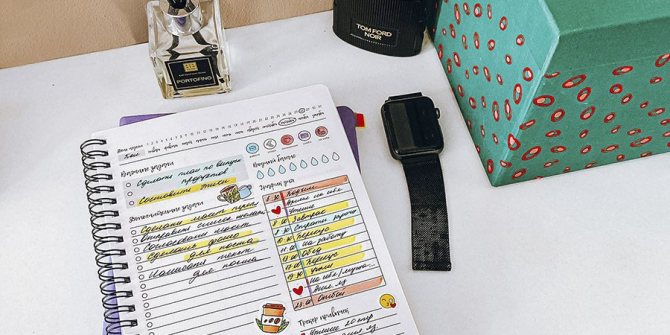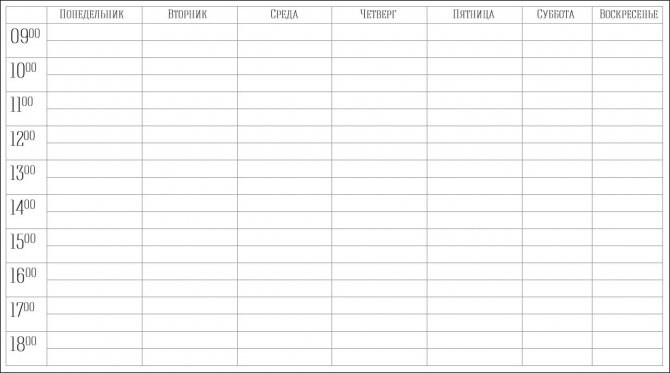Being in a good mood from the very morning, getting everything done and doing it productively, receiving only positive emotions, not forgetting about rest and yourself - this is probably what our ideal day looks like. What about the regular one? Urgent work, rush, a carload of unfulfilled tasks and severe fatigue in the evening. Agree, this option is much closer to reality. What is the problem? Why can't we live according to an ideal plan? What's going wrong?
The answer is simple: incorrect preparation of a plan for the day or lack thereof.
Why is it important to make a daily plan?
Imagine an ordinary morning: you open your eyes, check your phone, wash your face, have breakfast, and drive along your usual route to work. You always have this minimal initial plan that brings the system to life. Thanks to him, you don’t waste time on unimportant things. What if you make a plan like this for the whole day? It is not necessary to write everything down minute by minute; it is enough to make a list of tasks and meetings, plan the important, separate the urgent from the non-urgent. Yes, at first glance, it may seem complicated and it seems that such planning keeps within strict limits. But, on the contrary: the more clearly you see your day, the easier it is to deal with canceled meetings, rescheduled errands and other unpredictable factors. After new tasks appear, you are not lost, but know where they can be inserted without wasting time and stress. In essence, the daily plan is our confidence and fulcrum.
Frequently asked questions about daily plans
Go to contents
How to set tasks if the performing employee is not a direct subordinate to the manager?
Either obtain the authority to set such tasks within the framework of project subordination, or agree on the addition of a task with the immediate supervisor of the performer.
It is important to remember: time is not rubber. When a new task arrives, it “pushes” another task out of the plan. Priorities in setting tasks are a matter of competence of the immediate manager.
Go to contents
It turns out that this system introduces “total control” over the work of a subordinate? This should be done by his leader. Should this manager be controlled by his manager?
The manager controls the preparation of plans for his direct subordinates (example: the head of a department reviews the plans of department employees), but not necessarily every day. For loyal employees (1 year after the start of implementing regular management, there will be no others left in your company), the frequency of checks can be once every 3 days, once a week.
If one of your employees needs constant “total control,” ask yourself the question: “Do you need such an employee?”
A lot depends on the position and experience of a particular employee. And also on the type of planning that is used in addition to daily and weekly plans: monthly planning for projects, strategic plans for projects. If one of your employees needs constant “total control,” ask yourself the question: “Do you need such an employee?”
Go to contents
Some managers themselves do not want to control on a daily basis because... it takes time and attention
Planning work for your subordinates and monitoring its implementation are the direct responsibilities of the manager. In order to master this function, I recommend that you “pump up” your management competencies. I recommend your online course, which contains all the necessary techniques for implementing daily plans and reports - “Work reports and plans: How to increase employee productivity by 2 times and get rid of manual control” (all practical lessons on working with tasks are shown in the example work with the Bitrix24 service).
It is important to assess whether in your company there is a “bias” for managers in working to “produce results”. First of all, the manager must allocate time for managing subordinates , and producing results - in the second place and according to the residual principle of time. If you allocate enough time to the manager to manage, and at the same time he still strives to produce results with his own hands, while his subordinates are lazy, he is a good specialist, but a bad leader.
Go to contents
Jedi techniques: help in correctly drawing up a plan for the day

If you feel like you don’t have time to do anything, at the end of the evening you feel like a squeezed lemon, and every day you feel overwhelmed both in your work and in your personal life, then something is definitely going wrong. Your day will not be perfect without time for yourself and relaxation, without a feeling of satisfaction before bed.
How to close this problem? There are many methods, one of them is the use of “Jedi techniques”. And this is not about the battle on light beams with disorder, but real working techniques from the book of the same name. Before I discovered this method, I didn’t think about how often we use the expression “not enough time.” Now I realized that what we lack is not time, but intelligence. If we learn to set clear and achievable goals for ourselves, will we really struggle with this?
The main idea is this:
- We take on tasks that “seem to be burning,” but in fact nothing will happen if we postpone them until later or don’t complete them at all
- We do the little things and the routine, but don’t have enough energy for the important things. Perhaps you should start delegating?
- We don’t set aside at least 1 hour in the morning for an important, focused task. I emphasize: IN THE MORNING, before all matters, first of all. Otherwise, the routine will shift it again and the task will remain on your waiting list.
- Be sure to set aside a time when no one should disturb you and vice versa, when you can be available to everyone.
Key benefits of weekly scheduling:
- longer planning horizon compared to one day
- Saving employee time and significant savings of manager time
Go to contents
Weekly work plan
- How to make a plan?
- Go through all monthly project plans, take from them a list of tasks with a deadline by the end of the week + 5 days.
- Open your monthly work plan and write out some of the work from there.
- Include operational tasks (previously known or set by the manager) into the weekly plan.
- Tasks must be planned for the entire work week, taking into account the time reserve for introductory tasks (determined for each position individually).
- after all, that’s why the tasks and “unforeseen” ones may or may NOT exist.
- if the plan was not completed due to the fact that newly received tasks were being completed, then some of the tasks from the plan can be transferred to the next week.
Go to contents
How to work with “inbox”?
During the working day, our brain effectively thinks no more than 3 hours. And the maximum time to concentrate on information is, at best, only 40 minutes. But there is a state of “flow” that can stretch this time and increase it. What's the point? In energy.
After all, you can do everything on time and schedule, but at the same time feel exhausted and tired. Or you can “save thinking,” and thereby save both resources at the maximum: both time and energy. This is exactly one of the main components of an ideal day - balance.
Probably one of the main sources of such energy-time gaps should and can be called “inbox”. That is, everything that awaits a solution from us: messages in the messenger, unsorted work tasks, unread books, money transactions, unwritten ideas and other everyday tasks. And the most annoying thing is that they need to be resolved a little faster than usual.
And yet, how can you solve them when you don’t want to?
- If it takes no more than 5 minutes to solve a problem, do it right now.
- Work according to the Pomodoro method. For example: 30 minutes of fruitful work, 10 minutes of rest and back to work.
- Disable unnecessary notifications while working.
- Keep everything around you in order: chaos is very distracting and prevents us from focusing on one thing.
- Separate “thinking” from “doing”. Think only at the moment of making a decision, then do it and not think at this moment.
- Set minutes for rest or to “go have tea” as a task, limited in time and requiring completion.
Kindness Week
JOINT ACTIVITY OF TEACHERS AND CHILDREN MONDAY Topic of the week: Kindness Week Topic of the day: Friendship Day
| 1. MORNING |
| Printed board games: “Find an object of the same shape” (1st option) (30) |
| Target. Clarify the idea of the shape of objects. |
| Memorizing poems: Jokes “Where the jelly is, that’s where it sits.” Target. Develop memory and reading technique |
| Individual work on FEMP: “Sisters go mushroom hunting” (FEMP) Purpose. Strengthen your ability to build |
| row by size, establish correspondence between 2 rows, find the missing element of the row. |
| Didactic games: “Birds (animals, fish)” (89) |
| Target. Strengthen the ability to classify and name animals, birds, fish. |
| Morning exercises (health running, games, outdoor switchgear) Complex No. 5 |
| 2. ORGANIZED ACTIVITIES: |
| Individual-subgroup work: drawing “My friends” Goal. Choose your own material |
| for drawing and methods of transferring the drawing. |
| Conversations on the topic of the day: “Who is your friend?” Target. Learn to express your opinion about a friend who can be considered |
| friend and why; develop social and moral qualities. |
| 3. WALK |
| Observations Card No. 6 (August) Observation of the flight of birds Purpose. Learn to recognize birds: sparrow, |
| crow, tit, pigeon (in flight, on the ground); expand knowledge about the life of birds, their habits, and nutrition. |
| Role-playing games: “Rescue Service” |
| Target. Create conditions and encourage social creativity, develop the ability to distribute among |
| subgroups in accordance with the game plot and at the end of a given game action again. |
| unite into a single team. Expand children's understanding of the humane nature of work |
| rescue service, its necessity, mobility in emergency situations. Develop children's speech |
| Creative game: “Mysterious letters” Purpose. Develop imagination, ideas, ingenuity |
| children, to train the ability to compose sentences from individual words. |
| Physical exercises for balance and coordination of movements: Walking. |
| Spinning with eyes closed (with stopping and performing various figures). |
| Games for developing fine motor skills: “Make beads” |
| Target. Learn to make beads from cut felt-tip pen tubes; learn to make simple combinations |
| according to the instructions of the teacher and according to the scheme, develop fine motor skills of the hands, learn to concentrate on |
| one type of activity, develop and cultivate perseverance. |
| Outdoor games (plot, non-plot): “Firemen in training” |
| Target. Strengthen the ability to climb walls; develop attention. |
| "Jump" Goal. Jumping on two legs while moving around the flower bed. |
| Foot therapy. Sun and air baths (headdress): |
| Returning from a walk, taking a shower. KGN: Learn to wash and wipe your shoes. |
| DREAM. Relaxing relaxation music: sound of the sea |
| Hardening procedures, “health paths” Complex No. 5 |
| 4. HALF DAY |
| Construction games: “House for friends” Goal. Develop children's constructive qualities. |
| Reading fiction: L. Levin “Chest”. Target. Expand children's horizons; introduce |
| a new work; learn to express your opinion about the content of the work. |
| 5. WALK |
| Different types of theater: |
| Outdoor games: “Flock” (70) Goal. Develop rhythmic and expressive speech; intensify |
| dictionary on the topic “Birds”; develop sports skills. |
| "Cat and Mice" Goal. Continue to teach how to follow the rules of the game; intensify physical activity. |
| Organization of independent play activities for children: Games in the sports area. |
| Target. Continue to develop independence when choosing equipment for games, play together |
| Working with parents: Folder “Cultivating independence in a child” (advice from a psychologist). |
JOINT ACTIVITY OF TEACHERS AND CHILDREN TUESDAY Topic of the week: Kindness Week Topic of the day: Day of Understanding
| 1. MORNING |
| Word games: “Stop! Wand, stop” (82) Purpose. Continue to learn to listen to the sound of words; |
| practice independently naming words and clearly pronouncing the sounds in them. |
| Games and entertainment: “Shadow” Goal. Teach the “shadow” to act in the same rhythm as a person. |
| Creative games: “Right actions” Goal. To form in children ideas about positive and |
| negative human actions in everyday life. |
| Exercises to prevent visual impairment: “Pinocchio”, “Mirror”, “Water Circles” |
| Morning exercises (health running, games, outdoor switchgear) Complex No. 5 |
| 2. ORGANIZED ACTIVITIES: |
| Individual-subgroup work: “Gift for a friend” Purpose. Strengthen skills independently |
| Choose the material for work and additional accessories. |
| Conversations on the topic of the day: “Do you understand me” Purpose. A conversation to identify children’s knowledge of how |
| they understand what “Understanding” is, who needs to be understood and how to react to other people. |
| 3. WALK |
| Target walk. Topic: Card No. 7 (August) Looking at the willow |
| Target. Contribute to the generalization of ideas about the structure, growth and development of plants; develop skills |
| generalize according to essential features; expand children's understanding of parts of plants; bring up |
| interest in plants; gain experience in attentive and caring attitude towards growing plants. |
| Games to develop the perception of size: “Unfinished Pictures” |
| Target. Introduce children to the varieties of geometric shapes of round shapes of different sizes. |
| Creative play (moral education, children’s speech): “We are all the same” |
| Target. Encourage your child to have a friendly attitude towards people of other nationalities. |
| Promote the development of coherent speech, creative thinking and imagination. |
| Poems, nursery rhymes, songs (Teach to memorize small folklore forms): Jokes “Stupid Ivan...”. |
| Target. Continue to introduce children to folklore |
| Observing the work of adults: “In the garden” Purpose. Activate cognitive activity, |
| maintain a strong interest in observations. |
| Outdoor games (plot, non-plot): “Run to the named tree” (57) |
| Target. Train in quickly finding the named tree. |
| Foot therapy. Sun and air baths (headdress): |
| Returning from a walk, taking a shower. KGN: Strengthen the ability to comply with hygiene rules |
| while eating (do not lean back in the chair, do not spread your elbows or place them on the table) |
| DREAM. Relaxing relaxation music: Sounds of nature |
| Hardening procedures, “health paths” Complex No. 5 |
| 4. HALF DAY |
| Didactic games: “Journey” (172) |
| Target. Find your way by the names of familiar plants and other natural objects. |
| Reading fiction: S. Marshak “Cat House” (excerpts). |
| Target. Develop the ability to read a work in dialogue; develop expressive speech. |
| 5. WALK |
| Board and printed games: “What is this?” (49) Purpose. Develop logical thinking, memory, ingenuity. |
| Outdoor games: “Goalkeeper” (308) |
| Target. Strengthen the ability to navigate in space; develop reaction speed and movement accuracy. |
| Ball games: "Don't fall" Goal. Strengthen the ability to pass the ball back and forth with straight arms. |
| Organization of independent play activities for children: |
| Invite the children to make a funny toy “Hedgehog, no head or legs visible” from leaves. |
| Working with parents: Consultation “On the rules of a child’s life in the family” |
JOINT ACTIVITY OF TEACHERS AND CHILDREN WEDNESDAY Topic of the week: Kindness Week Topic of the day: Day of Caring
| 1. MORNING |
| Games for speech development: “Invent it yourself” |
| Target. Learn to correctly form sentences with a given number of words. |
| Outdoor games with running and jumping: “Funny Centipede” |
| Target. Jumping on two legs while moving forward. |
| Fun games: “Recognize by sound” (11) Purpose. Develop observation skills. |
| Games to develop fine motor skills: “Make a pattern or picture from rubber bands” |
| Target. Teach children to make a pattern from bank rubber bands, develop fine motor skills, imagination, |
| hand-eye coordination, learn to work according to the scheme. |
| Morning exercises (health running, games, outdoor switchgear) Complex No. 5 |
| 2. ORGANIZED ACTIVITIES: |
| Individual-subgroup work: drawing “How I take care of my pet.” |
| Target. Use unconventional drawing techniques in your work - using a poke and a hard brush. |
| Conversations on the topic of the day: “Caring” Purpose. Conversation to deepen knowledge about the family; about whom and how |
| take care; develop moral qualities. |
| 3. WALK |
| Observations: Card No. 8 (August) Rain observation |
| Target. Continue to introduce children to natural phenomena. |
| Games with sand, water, natural materials: “Cook” |
| Target. To consolidate children's knowledge about the properties of wet and dry sand. |
| Games with physical education equipment: “Find where it’s hidden” |
| Target. Learn to navigate in space. |
| Games - travel: “Across the sea of games” Goal. Development of coordination of movements and fine motor skills of the hands. |
| Outdoor games (plot, non-plot): “Catch up with your partner” |
| Target. Perform movements at the teacher’s signal; clearly navigate when finding your match. |
| Foot therapy. Sun and air baths (headdress): |
| Returning from a walk, taking a shower. KGN: Strengthen the ability to wash quickly and accurately |
| DREAM. Relaxing relaxation music: bird sounds |
| Hardening procedures, “health paths” Complex No. 5 |
| 4. HALF DAY |
| Leisure evening: “What is kindness” Purpose. Development of ethical ideas; consolidate the ability to demonstrate |
| A friendly attitude towards others. |
| Reading fiction: “Blue Bird”, Turkmenistan, arr. A. Alexandrova and M. Tuberovsky. |
| Target. Replenishing children's literary baggage; continue to introduce foreign literature. |
| 5. WALK |
| Physical exercises to develop basic types of movements: Crawling, climbing. |
| Climbing through a hoop in different ways |
| Outdoor games with sports toys: “Keys” (rus n.i.) (92) Purpose. Develop attention and speed. |
| “Water the horse” (310) Purpose. Develop dexterity of movements. |
| Didactic games: “What is around us?” (68) |
| Target. Learn to divide two- or three-syllable words into parts and pronounce each part of the word. |
| Organization of independent play activities for children: Searching for beautiful flowers. |
| Target. Development of independence, the ability to use flowers in the game. |
| Working with parents: Joint activity “Involving parents in organizing a leisure evening |
| "What is kindness?" |
JOINT ACTIVITY OF TEACHERS AND CHILDREN THURSDAY Topic of the week: Kindness Week Topic of the day: Hug Day
| 1. MORNING |
| FEMP games: “Find by touch” |
| Target. Teach children to compare the results of a visual-tactile examination of the shape of an object. |
| Games for the perception of correct sound pronunciation, clarification, consolidation, activation of the dictionary: |
| “Who can come up with the most words” (101) Purpose. Activate the dictionary; expand your horizons. |
| “How to say it differently” Purpose. Exercise children in naming one of the synonyms. |
| Morning exercises (health running, games, outdoor switchgear) Complex No. 5 |
| Formation of KGN: Strengthen the ability to correctly use a napkin as needed. |
| 2. ORGANIZED ACTIVITIES: |
| Individual-subgroup work: A. Barto “Vovka is a kind soul” (reading passages) |
| Target. Learn to reason and analyze the actions of the hero. |
| Conversations on the topic of the day: “What it means to be kind” Goal. Communicate that hugs are important |
| role in human life and development. |
| 3. WALK |
| Observations Card No. 9 Observing the weather (signs) Purpose. Develop the ability to install |
| cause-and-effect relationship between observed natural phenomena; consolidate knowledge about signs |
| season; remember proverbs and sayings on this topic. |
| Games with crawling and climbing: “Bears and Bees” |
| Target. Strengthen the ability to climb over obstacles. |
| Creative games: “My best friend” Goal. Develop creativity. Learn to display your own in a drawing |
| mood, features of another person’s appearance. |
| Physical exercises to develop basic types of movements: Jumping. |
| Jumping with a sandbag clamped between your legs. |
| Outdoor games (plot, non-plot): “Hunters and Ducks” (209) Goal. Accuracy development. |
| “This is how our feet walk along the wide path” |
| Target. Practice walking with high knees. |
| Foot therapy. Sun and air baths (headdress): |
| Returning from a walk, taking a shower. KGN: conversation “Let’s remember how to eat properly” |
| DREAM. Relaxing relaxation music: Music for relaxation |
| Hardening procedures, “health paths” Complex No. 5 |
| 4. HALF DAY |
| Examination of pictures, albums, illustrations: Examination of pictures depicting different |
| situations; be able to analyze and discuss the actions of characters |
| Reading fiction: “White and Rosette”, trans. with him. L. Kon. |
| Target. Replenishing children's literary baggage with fairy tales. |
| 5. WALK |
| Outdoor games of low mobility: “Throw the ball to an adult and name the animals” (227) |
| Target. Expand your vocabulary through the use of generalizing words; develop attention and memory. |
| Games to develop attention: “Vegetables and fruits” |
| Target. Develop attention, consolidate knowledge about vegetables and fruits. |
| Games using building materials: Build with sticks |
| Target. Develop children's imagination; make figures according to the idea. |
| Household work: Maintain the appearance of the dolls: select clothes, comb, tie |
| bow. Goal: to foster a sense of satisfaction from the work done. |
| Independent activity of children: Using pinwheels and plumes, check the strength of the wind. |
JOINT ACTIVITY OF TEACHERS AND CHILDREN FRIDAY Topic of the week: Kindness Week Topic of the day: Day of Good Wishes
| 1. MORNING |
| Games for speech development: “Guessing riddles” (66) |
| Target. Expand the stock of nouns in the active dictionary. |
| Outdoor games with running and jumping: “From bump to bump” Goal. Develop long jump skills. |
| Fun games: “Hurry up to catch it” (19) Goal. Develop dexterity and precision of movement. |
| Morning exercises (health running, games, outdoor switchgear) Complex No. 5 |
| Formation of KGN: Strengthen the ability to clean your clothes |
| 2. ORGANIZED ACTIVITIES: |
| Individual-subgroup work: “Gift for a friend” Purpose. Come up with your own gift |
| for a friend(s). |
| Conversations on the topic of the day: “Day of Good Wishes” Purpose. Develop the ability to say pleasant words to each other |
| 3. WALK |
| Observations: Card No. 10 (August) Observation of butterflies Purpose. Expand knowledge and understanding about |
| features of the appearance and life manifestations of insects; learn to analyze, establish |
| simple cause-and-effect relationships; make generalizations; activate memory and attention; |
| enrich vocabulary; develop coherent speech and logical thinking. |
| Games with educational toys: “How many objects?” (131) Purpose. Teach subject counting; develop |
| quantitative representations; understand and name numerals. |
| Games with physical education equipment: “Touch the ball” Goal. Strengthen the ability to throw and catch a ball. |
| Travel games: “Through the woods.” Goal: to develop coordination and fine motor skills of the hands |
| Outdoor games (plot, non-plot): “Blind Man's Bluff” (75) Purpose. Develop attention. |
| “Butterflies, Frogs and Herons” (312) Purpose. Develop imitative movements. |
| Foot therapy. Sun and air baths (headdress): |
| Returning from a walk, KGN: Strengthen the ability to maintain order in the washroom. |
| DREAM. Relaxing relaxation music: Lullabies |
| Hardening procedures, “health paths” Complex No. 5 |
| 4. HALF DAY |
| Looking at pictures, albums, illustrations: “Who is my friend” Purpose. Looking at photos |
| Friends, the ability to talk about the positive (negative) qualities of comrades. |
| Conversation with children on the topic of the week: “What is kindness?!” Target. Generalizing children's knowledge on the topic; |
| develop the ability to generalize, reason, analyze, and draw conclusions. |
| 5. WALK |
| Leisure evening: “Let's tell a fairy tale” Purpose. A theatrical performance for younger children; |
| development of dialogical speech, emotional state of children. |
| Physical exercises to develop basic types of movements: Throwing, catching, throwing. |
| Throwing the ball to each other from a sitting position with legs crossed. |
| Didactic games: “How many objects?” (131) Purpose. Teach subject counting; develop |
| quantitative representations; understand and name numerals. |
| Independent activity of children: With external materials. |
| Target. Develop independence when choosing attributes and games. |
| Working with parents: Consultations on requests |
Schedule
There is an opinion that after graduating from university, the daily routine disappears from a person’s life forever. This is partly true, but in a good way it is useful not only for schoolchildren or students. Of course, you shouldn’t maniacally schedule every action you take in seconds, but ideally you should still have some time boundaries.
For example, you need to pick up a tax certificate. Look at the operating hours of the desired department and schedule yourself approximate hours at what time it would be best for you to be there. Or another situation: your boss asked you for a report urgently, today. Review your actions in your head and objectively set yourself a deadline, then it will be much easier for your brain to complete the task.
Attention ! Try to objectively estimate the time spent on tasks. It is better to plan it with a reserve in case of unforeseen circumstances.
How to make a plan for the day: example

Let's jump right into an example. I repeat that you can keep a daily plan either schematically or in great detail. I’ll show you my version, which is easy to customize for yourself and, if something happens, change plans without harming your time and nerves:
From 8.00. until 10.00. My morning begins. Mandatory items: checking messages on your phone and quickly responding to messages (no more than 5-10 minutes), time for yourself (15 minutes in the bathroom), breakfast (no more than 20 minutes), some activities (no less than 15 minutes), selection outfit + light makeup (no more than 20 minutes), urgent matters (no more than 20 minutes). That is, in essence, these are all the morning rituals that need to be done for a good start to the day.
From 10 to 10.30. Time spent on transport. Be sure to include it in your plan for a complete vision of your day.
From 10.30 to 13.00. Brainstorming: I solve the most important work issues, get creative and completely immerse myself in work. If you are making a plan for the day, it is better to write in more detail, entering each task. For example: call a printing house, write two posts, make a video about a new glider, etc.
From 13.00. until 13.40. Dinner time.
From 13.40. until 14.00. A short walk or chat with colleagues.
From 14.00. until 18.00. Immersion in work: here it is better to write down every task and meeting again. Don't be afraid to get a little hung up on the little things, it will be useful.
From 18.00. until 19.30. Training/English courses/other useful activities.
From 19.30. until 21.30. Time with family/friends/outing. No matter how introverted you are, always leave room for a fun part of the day. At least an hour.
From 21.30 to 22.00. Preparing for tomorrow: write down tasks for the next day, summarize in your diary, think about what to wear to the meeting tomorrow and what to take with you.
From 22.00. until 00.00. Rest and preparation for bed. This includes nightly beauty treatments, showering, reading books or watching an episode of your favorite TV series. Anything that will help you relax and get ready for tomorrow.
Of course, if you are a mother on maternity leave or a student who combines study with work, you won’t be able to stick to this schedule. In this case, draw up a rough schedule for the day the day before, taking into account at least the most important and priority.
Important tips for creating the perfect plan to get everything done
It seems that we already know everything about the ideal plan. Not really. There are several important details that will help make everything even better and more productive:
- Plan your day the night before or in the morning. This is the most optimal time, when ideas are still relevant and, if possible, it will be easier to make adjustments.
- Don’t forget to mark each completed task with a tick or marker, and also summarize the results.
- Every evening, analyze the past day, what caused difficulties, why you couldn’t do one thing and why another didn’t cause such problems.
- Remember to separate important tasks from unimportant ones, urgent from non-urgent ones. This can be done with special symbols directly in the diary.
- Distribute your tasks evenly throughout the week.
- If you couldn’t complete one of the tasks, don’t worry. Reschedule it to another day convenient for you.
Print weekly planner template
Well, we have learned the basics of planning, time to expand our capabilities. This time we will try to plan the entire upcoming week at once. Yes, it is difficult, we don’t argue, but the skill is very useful and necessary.
In general, we would recommend putting a piece of paper next to the weekly planner template and writing down all the main tasks for the next 7 days. Directly in a row without breaking them down by day. Then determine which of these tasks are urgent and important and try to get rid of them right away. They are counterproductive, as many time management experts have been saying for 100 years or more.
By the way, the distribution of your tasks according to such parameters is very competently implemented in the time management tool “Eisenhower Matrix”. I won’t go into too much detail about this technique—it’s better to read about it separately at this link.
This is what a template for printing a weekly planner looks like:

Download it in Microsoft Word or PDF format. If you need to place the planner on A5 size paper, then select the appropriate option when setting up printing.
Want this printable template? Click on the “Download template” button:
Where is the right place to make a plan for the day?
You can plan your day anywhere you want. But if you want it to be truly detailed and functional, then it is better to opt for a diary.

Diary notebook
Binding:
gluing
Designed for:
3 months
Price:
590₽ View

Diary on a spring
Binding:
spring
Durable:
4 months
Price:
990₽ View


